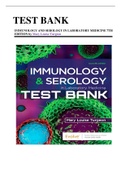TEST BANK
IMMUNOLOGY AND SEROLOGY IN LABORATORY MEDICINE 7TH
EDITION by Mary Louise Turgeon
,Chapter 01: Highlights of the Innate and Adaptive Immune Systems
Turgeon: Evolve Resources for Immunology & Serology in Laboratory Medicine, 7th
Edition
MULTIPLE CHOICE
1. The “father” of immunology is generally considered to be
a. Koch.
b. Pasteur.
c. Gram.
d. Salk.
ANS: B
Louis Pasteur is generally considered to be the “father of immunology.”
DIF: Cognitive Level: I
2. An early form of immunization was practiced by the
a. Romans.
b. Greeks.
c. Chinese.
d. Native Americans.
ANS: C
Beginning about 1000 AD, the Chinese practiced a form of immunization by inhaling dried
powders derived from the crusts of smallpox lesions.
DIF: Cognitive Level: I
3. A specific function of the immune system is to
a. recognize self from nonself.
b. defend the body against nonself.
c. amplify specific functions.
d. Both A and B.
ANS: D
The function of the immune system is to recognize self from nonself and defend the body
against nonself. Such a system is necessary for survival. The immune system also has
nonspecific effector mechanisms that usually amplify the specific functions. Nonspecific
components of the immune system include mononuclear phagocytes, polymorphonuclear
leukocytes, and soluble factors (e.g., complement).
DIF: Cognitive Level: I
4. An undesirable consequence of immunity is
a. natural resistance.
b. acquired resistance to infectious diseases.
c. an autoimmune disorder.
d. recovery from infectious disease.
ANS: C
, The desirable consequences of immunity include natural resistance, recovery, and acquired
resistance to infectious diseases. A deficiency or dysfunction of the immune system can cause
many disorders. Undesirable consequences of immunity include allergy, rejection of a
transplanted organ, or an autoimmune disorder.
DIF: Cognitive Level: I
5. The immune system has various distinctive characteristics except;
a. specificity.
b. memory.
c. mobility.
d. noncooperation among different cells.
ANS: D
The immune system is composed of a large, complex set of widely distributed elements, with
the distinctive characteristics of specificity, memory, mobility, replicability, and cooperation
among different cells or cellular products. Specificity and memory are characteristics of
lymphocytes in the immune system. Nonspecific elements of the immune system demonstrate
mobility. In addition, specific and nonspecific cellular components of the immune system can
replicate. Cooperation is required for optimal functioning, and interaction involves specific
cellular elements, cell products, and nonlymphoid elements.
DIF: Cognitive Level: I
6. Hematopoiesis occurs in the yolk sac during the
a. immediate hours after conception
b. second month of gestation.
c. second trimester of gestation.
d. periods of severe anemia in children.
ANS: A
The sites of blood cell development, or hematopoiesis, follow a definite sequence in the
embryo and fetus. Hematopoiesis occurs in the yolk sac during the second month of gestation.
DIF: Cognitive Level: II
7. The sequence of blood cell development in the embryo and fetus is
a. yolk sac, liver-spleen, bone marrow.
b. yolk sac, bone marrow, liver/spleen.
c. liver-spleen, yolk sac, bone marrow.
d. bone marrow, liver-spleen, yolk sac.
ANS: A
The first blood cells are primitive red blood cells (erythroblasts; RBCs) formed in the islets of
the yolk sac during the first 2 to 8 weeks of life. Gradually, the liver and spleen replace the
yolk sac as the sites of blood cell development. By the second month of gestation, the liver
becomes the major site of hematopoiesis, and granular types of leukocytes have made their
initial appearance. The liver and spleen predominate from about 2 to 5 months of fetal life. In
the fourth month of gestation, bone marrow begins to produce blood cells. After the fifth fetal
month, bone marrow begins to assume its ultimate role as the primary site of hematopoiesis.
, DIF: Cognitive Level: II
8. The primary function of mature neutrophils is
a. to reduce inflammation.
b. to lyse parasites in the circulatory system.
c. antigen recognition.
d. phagocytosis.
ANS: D
Various phagocytic cells continually circulate throughout the blood, lymph, gastrointestinal
system, and respiratory tract. When trauma occurs, the neutrophils arrive at the site of injury
and can be found in the initial exudate in less than 1 hour. Monocytes are slower in moving to
the inflammatory site. Macrophages resident in the tissues of the body are already in place to
deal with an intruding agent. Additional macrophages from the bone marrow and other tissues
can be released in severe infections.
DIF: Cognitive Level: II
9. Primary granules, or azurophilic granules, in neutrophils contain
a. lysozyme.
b. myeloperoxidase.
c. lactoferrin.
d. Both A and B.
ANS: D
Granules in the phagocyte cytosol contain degradatory enzymes of three types
1. Primary, or azurophilic, granules containing enzymes (e.g., lysozyme,
myeloperoxidase)
2. Secondary, or specific, granules containing substances such as lactoferrin.
3. Tertiary granules containing substances such as caspases
DIF: Cognitive Level: I
10. The origin of a condition when eosinophils are increased in the circulating blood is associated
with:
a. fungus
b. parasitic amoeba
c. allergic reactions
d. bacteria
ANS: C
An increase in eosinophils is associated with a wide variety of conditions, but especially with
allergic reactions, drug reactions, certain skin disorders, parasitic infestations, collagen
vascular diseases, Hodgkin disease, and myeloproliferative diseases.
A functional property related to the membrane receptors of the eosinophil is the cell’s ability
to interact with the larval stages of some helminth parasites and damage them by oxidative
mechanisms. Certain proteins released from eosinophilic granules damage antibody-coated
Schistosoma parasites and may account for damage to endothelial cells in hypereosinophilic
syndromes.
DIF: Cognitive Level: I




